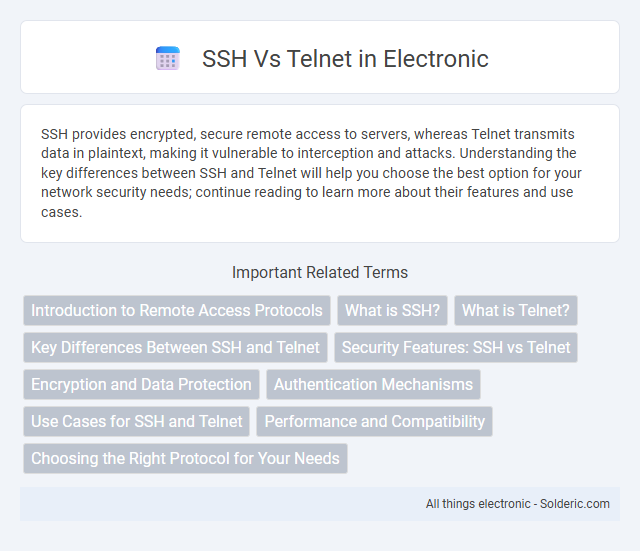SSH provides encrypted, secure remote access to servers, whereas Telnet transmits data in plaintext, making it vulnerable to interception and attacks. Understanding the key differences between SSH and Telnet will help you choose the best option for your network security needs; continue reading to learn more about their features and use cases.
Comparison Table
| Feature | SSH (Secure Shell) | Telnet |
|---|---|---|
| Security | Encrypts data, secure authentication | No encryption, data sent in plain text |
| Port | Default port 22 | Default port 23 |
| Use Case | Secure remote administration and file transfer | Basic remote terminal access in trusted networks |
| Authentication | Supports passwords, public key, and multi-factor | Only password-based |
| Data Integrity | Ensures data integrity and confidentiality | No integrity checks |
| Configuration | Complex setup but highly configurable | Simple setup, less secure |
Introduction to Remote Access Protocols
SSH and Telnet are fundamental remote access protocols used for managing network devices and servers. SSH (Secure Shell) provides encrypted communication, ensuring secure data transfer and authentication, while Telnet transmits data in plain text, making it vulnerable to interception and unauthorized access. Understanding these protocols helps you choose the appropriate method for secure and efficient remote administration.
What is SSH?
SSH (Secure Shell) is a cryptographic network protocol used for secure remote login and other secure network services over an unsecured network. It provides strong authentication and encrypted data communications between two computers, typically used to access servers and network devices securely. Unlike Telnet, SSH protects sensitive information such as passwords and command inputs from interception by encrypting the entire session.
What is Telnet?
Telnet is a network protocol that allows remote access to another computer over a TCP/IP network using a command-line interface. Unlike SSH, Telnet transmits data in plain text, making it vulnerable to interception and unauthorized access. For secure remote connections, you should prefer SSH, which encrypts the communication between your device and the server.
Key Differences Between SSH and Telnet
SSH (Secure Shell) encrypts all data transferred between your device and the remote server, ensuring confidentiality and protection against eavesdropping, while Telnet transmits data in plain text, exposing sensitive information to potential interception. SSH supports strong authentication methods, including public key authentication, whereas Telnet relies primarily on basic username and password authentication without encryption. SSH operates on port 22 by default, offering a secure communication channel, whereas Telnet uses port 23 and lacks built-in security features, making SSH the preferred choice for secure remote access.
Security Features: SSH vs Telnet
SSH provides robust security features including strong encryption, secure authentication methods, and protection against eavesdropping and man-in-the-middle attacks, making it the preferred choice for secure remote management. Telnet transmits data in plain text without encryption, leaving your login credentials and communications vulnerable to interception and unauthorized access. Choosing SSH ensures your remote sessions maintain confidentiality and integrity, safeguarding critical system information.
Encryption and Data Protection
SSH (Secure Shell) provides robust encryption protocols such as AES, ensuring all transmitted data, including passwords and commands, is securely encrypted to prevent interception or eavesdropping. Telnet transmits data in plain text without encryption, making it vulnerable to packet sniffing and unauthorized access on unsecured networks. For sensitive or remote server management, SSH is the preferred choice due to its strong data protection and secure authentication mechanisms.
Authentication Mechanisms
SSH uses robust public key cryptography and password-based authentication to secure access, ensuring encrypted communication between your device and the server. Telnet relies on plaintext transmission without encryption, making its username and password vulnerable to interception during authentication. Choosing SSH enhances security by protecting your credentials with advanced authentication mechanisms resistant to eavesdropping and unauthorized access.
Use Cases for SSH and Telnet
SSH is ideal for secure remote administration of servers, encrypted file transfers, and managing network devices over untrusted networks, ensuring confidentiality and integrity. Telnet remains useful for accessing legacy systems within secure, controlled environments or for troubleshooting network services that do not support encryption. Your choice between SSH and Telnet depends on whether security is paramount or if compatibility with older protocols is required.
Performance and Compatibility
SSH offers superior performance over Telnet by encrypting data, minimizing latency and ensuring secure remote connections across diverse network environments. It supports a wide range of operating systems, including Unix, Linux, and Windows, making it compatible with most modern infrastructure. Telnet, while faster in unsecured internal networks, lacks encryption and is limited in compatibility, primarily functioning on legacy systems and older devices.
Choosing the Right Protocol for Your Needs
SSH provides encrypted communication, making it ideal for secure remote access and data transfer, whereas Telnet transmits data in plaintext, posing significant security risks. Your choice should prioritize SSH when confidentiality and protection against interception are crucial, especially in environments that handle sensitive information. Telnet may still be appropriate for internal, non-sensitive network management where encryption is less critical.
SSH vs Telnet Infographic

 solderic.com
solderic.com